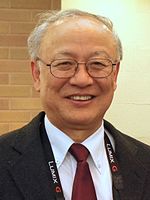Fukuyama clutch
The Fukuyama coupling is a name reaction in organic chemistry . It is a palladium - catalyzed cross - coupling between thioesters and zinc organyls . It was published in 1998 by Hidetoshi Tokuyama, Satoshi Yokoshima, Tohru Yamashita and Tohru Fukuyama .
Overview reaction
In the Fukuyama coupling, a thioester is reacted with an organyl zinc (ZnR 3 I) over a palladium catalyst. In the protocol developed by Fukuyama, bis (triphenylphosphine) palladium chloride is used as the catalyst. Other catalysts, such as Pearlman's catalyst Pd (OH) 2 / C, can also be used.
mechanism
In the first step, the palladium catalyst inserts into the CS bond of thioester 1 . There is an oxidative addition on the palladium. The species 2 formed in this way exchanges the thiolate for the organic residue bound to the zinc through transmetalation . The driving force here is the high thiophilicity of zinc. Species 3 can now undergo reductive elimination. The palladium catalyst is recovered and the CC bond is made, resulting in a ketone 4 .
Individual evidence
- ↑ Hidetoshi Tokuyama, Satoshi Yokoshima, Tohru Yamashita, Tohru Fukuyama: A novel ketone synthesis by a palladium-catalyzed reaction of thiol esters and organozinc reagents . In: Tetrahedron Letters . tape 39 , no. May 20 , 1998, pp. 3189-3192 , doi : 10.1016 / S0040-4039 (98) 00456-0 ( elsevier.com [accessed April 7, 2020]).
- ↑ Yoshikazu Mori, Masahiko Seki: Pd (OH) 2 / C (Pearlman's Catalyst): A Highly Active Catalyst for Fukuyama, Sonogashira, and Suzuki Coupling Reactions . In: The Journal of Organic Chemistry . tape 68 , no. 4 , February 2003, ISSN 0022-3263 , p. 1571–1574 , doi : 10.1021 / jo0265277 ( acs.org [accessed April 7, 2020]).


